This article was medically reviewed by Janice Litza, MD. Dr. Litza is a board certified Family Medicine Physician in Wisconsin. She is a practicing Physician and taught as a Clinical Professor for 13 years, after receiving her MD from the University of Wisconsin-Madison School of Medicine and Public Health in 1998.
There are 14 references cited in this article, which can be found at the bottom of the page.
This article has been viewed 322,985 times.
Experts agree that while vertigo is a very frustrating condition, there are a number of tricks to help you relieve the sensation of dizziness or spinning.[1] Studies have shown that understanding the cause of your vertigo can be crucial for determining your best treatment options, so if you're having persistent or recurring episodes of dizziness, you'll want to work with your health care provider to figure out the best approach for you. If physical maneuvers don't work, you may need to consider medications or surgical procedures.[2]
Steps
Alleviating Vertigo Immediately
-
1Move slowly. If vertigo hits, the worst thing you can do is to change your position quickly. Reduce your feelings of dizziness by moving extremely slowly. These slow movements will allow you to focus more easily and clear your head. You should also have something stable (such as a wall or railing) to lean on when standing up or moving around.[3]
- If you need to, take short breaks between slow movements.
- Vertigo shouldn't keep you from you moving or getting out of bed in the morning. Don't be afraid to move -- just do so with care and patience!
-
2Avoid activities that involve looking up. Looking up for extended periods of time can cause disorientation and feelings of unpleasantness. You'll feel better if you can keep your head level and parallel to the ground as much as possible. Use slow movements whenever you tilt your head in any direction.[4]
- While it shouldn't make your symptoms too much worse if you need to look up for a moment or two, avoid doing things like cleaning a high shelf or watching a screen that's above your eye level.
- You may also experience discomfort when you look down.[5]
Advertisement -
3Avoid focusing on moving objects. Looking at fast-moving objects like a passing car or train may make you feel more dizzy. You might also have trouble focusing on things that are either too close to you or too far way. If you're struggling to focus on anything, close your eyes and take a few deep breaths. This may improve your symptoms.[6]
-
4Lie in an angled position. Lying down flat can make your vertigo worse, while keeping your head slightly elevated may help reduce the dizzy feeling. Sit or lie at an angle by propping yourself up with pillows or using a recliner.[7]
-
5Sit in a calm room. Placing yourself in a quiet, dark room may help ease the dizziness and other unpleasant symptoms associated with vertigo. Lie propped up on your bed or in a chair. Turn off all lights and electronic devices. Cut off the television and radio. This calm environment can help reduce the vertigo.[8]
- Try to do this for a minimum of twenty minutes. This may be enough time for your symptoms to pass. If you're still feeling dizzy after twenty minutes, rest for an additional twenty.
Trying the Epley Maneuver
-
1Determine which ear is causing the vertigo. Sit on your bed in a position that will make your head hang slightly off the edge when you lie down. Turn your head to the right while sitting, then lie down quickly. Wait one minute and see if you feel dizzy. Repeat on the left side. If you feel dizzy when you turn right, your right ear is your bad ear. If dizziness happens when you turn left, it's your left ear.[9]
-
2Turn your head 45 degrees slowly. Sit on the edge of your bed. Turn your head 45 degrees to whichever side is causing the vertigo. Don't turn your head so far that your chin is over your shoulder.[10]
- For example, if your vertigo comes from your left ear, you will turn your head to the left. If it comes from the right, turn your head 45 degrees to the right.
-
3Lay your head back. Next, quickly lean your head back onto the bed with a pillow beneath your shoulders. Your head should still be turned. Keep your neck and shoulders relaxed. Hold this for one to two minutes.[11]
-
4Turn your head 90 degrees. While lying down, slowly turn your head 90 degrees in the opposite direction. Don't raise your head. It should instead be resting against the edge of the bed. Hold your head in this position for one to two minutes.[12]
- If your vertigo comes from the left ear, you will turn your head 90 degrees to the right. If it's from the right, turn to the left.
-
5Roll onto your “good side.” Turn your body over so that you're lying on the same side as your good ear. Turn your head (keeping your body on its side) so you're looking at the floor. Hold this position for one to two minutes.[13]
- If your vertigo comes from the left ear, you will move your body onto your right side.
-
6Repeat the movements if you need to. For some people, this series of positions will immediately relieve their symptoms. For others, the maneuver may need to be repeated a few times. If you're still experiencing symptoms, continue to do the treatment three times per day. Stop when you experience no symptoms for 24 hours.[14]
- You can do the movements once when you wake up, once at lunch, and once when you go to bed at night.
-
7Avoid lying flat or tilting your head up or down for one week. Use a recliner or several pillows in bed to sleep at a 45 degree angle. You should also try to keep your head as level as possible. This should help prevent your vertigo symptoms from coming back.
- It's also a good idea to avoid lying on your “bad side.”
- If you need to shave or put in eye drops, do so without tilting your head back.
Using the Foster Maneuver
-
1Figure out which ear is making you have vertigo. Sit on your bed so that your head hangs a little off the edge when you lie down. While sitting down, turn your head to the right, then lie down. Wait a minute and check for dizziness. Do it again on the left side. If you feel dizzy when you turn right, your right ear is your bad ear. If dizziness happens when you turn left, it's your left ear.[15]
-
2Kneel on the floor. Begin this method by kneeling on the floor. Don't rest your upper legs and buttocks on your calves. Your bent legs should instead form a right angle. Place your hands on the floor directly below your shoulders. Raise your chin and look up at the ceiling for about five to ten seconds.[16]
- Put a towel or pad under your knees if you do not have carpeted flooring.
-
3Lean your head to the floor. While on your hands and knees, tuck your chin towards your chest as you lean your head towards the floor. Bend forward until you touch the floor with your forehead while keeping your hips elevated. Hold this position for around 30 seconds.[17]
-
4Turn your head. While in this position, turn your head towards the side of the ear with the vertigo. You should be facing your shoulder. Hold this position for 30 seconds.[18]
- For example, if your left ear is the affected ear, turn your head to the left.
-
5Raise the front of your body. Quickly, lift your head and push yourself up until your back is flat. Your head should be at the same level as your back, so that your ear is parallel to the floor. Your head should be held in a 45 degree angle as you rest on all fours. Hold this position for 30 seconds.[19]
-
6Lift your head. Lift your head so that the top of your head is pointing to the ceiling and your chin is pointing to the floor. Your head should still be angled towards the shoulder of your affected ear. Stand up very slowly.
-
7Repeat this process. If you don't feel relief, do these steps again. It may take multiple tries for your vertigo to go away. However, rest for 15 minutes after the first attempt before you try again. While there isn't a limit to how many times you can try this maneuver, you may want to consult a doctor if it's not working for you after you try it three or more times.[20]
-
8Sleep on your “good side” propped up for a week. Lie down so your affected ear is facing up. Use two pillows to prop your body up. You can use an additional pillow under your side to keep from rolling over during the night.[21]
Seeking Medical Attention
-
1Visit your doctor. Though vertigo is often caused by something minor, you may have an underlying condition that's causing your symptoms. Vertigo may point to an infection or may be a sign of something more serious. Go see your doctor if vertigo is a recurring problem.[22]
-
2Take antibiotics. Vertigo often occurs when you have an inner ear infection or fluid in your middle ear. This may not indicate that you have an infection. This may simply be the result of allergies or problems with the Eustachian tubes. Viral infections will go away on their own and can't be treated with medicine, but if the vertigo is related to a bacterial infection, your doctor can prescribe antibiotics to clear it up.[23]
- If the fluid in your inner or middle ear is infected, then an appropriate treatment for an infection might include antibiotics, a nasal steroid, or saline spray.
-
3Take vertigo medication. In some cases of vertigo, the doctor will prescribe specific vertigo medication to help alleviate the symptoms. This is usually only prescribed if you have certain conditions, like vestibular neuronitis, central vertigo, or Meniere's disease. The medications that your doctor may give you are prochlorperazine or antihistamines.[24]
- These medications are taken for anywhere between three to fourteen days. If they work, your doctor may decide to give you pills to keep at home to be used on an as-needed basis.
-
4Get a referral to a specialist. If your condition does not improve, your doctor may refer you to an ear, nose, and throat (ENT) doctor. The ENT specialist will have more training and experience dealing with these specific problems, so they may be able to provide you with a more effective treatment plan.[25]
- A specialist will usually be consulted if the head exercises don't work, the symptoms last for more than a month, or the symptoms are unusual or severe. An ENT specialist will also be called if you're experiencing hearing loss.
- The ENT will likely use an electronystagmogram (ENG) to see if there are problems in the connections between your inner ear, brain, and nerves. They may also order an MRI.
- A physical therapist can also help you to do the exercises properly, so you can also ask your doctor for a referral to this type of specialist.
-
5Undergo surgery. In rare and extreme cases, your doctor may suggest that you undergo surgery. During surgery, they will insert a bone plug into your ear to block parts of the inner ear that cause vertigo.[26]
- This is used when no other treatment helps and the vertigo affects your quality of life.
Expert Q&A
-
QuestionWill these head maneuvers shorten vertigo timespan?
 Janice Litza, MDDr. Litza is a board certified Family Medicine Physician in Wisconsin. She is a practicing Physician and taught as a Clinical Professor for 13 years, after receiving her MD from the University of Wisconsin-Madison School of Medicine and Public Health in 1998.
Janice Litza, MDDr. Litza is a board certified Family Medicine Physician in Wisconsin. She is a practicing Physician and taught as a Clinical Professor for 13 years, after receiving her MD from the University of Wisconsin-Madison School of Medicine and Public Health in 1998.
Board Certified Family Medicine Physician The maneuvers should completely resolve the vertigo if there isn't another problem causing the symptoms. Often people will repeat them whenever they begin to experience vertigo again and doing the maneuvers may resolve the problem more quickly.
The maneuvers should completely resolve the vertigo if there isn't another problem causing the symptoms. Often people will repeat them whenever they begin to experience vertigo again and doing the maneuvers may resolve the problem more quickly. -
QuestionWith blowing my nose with a head cold cause vertigo?
 Janice Litza, MDDr. Litza is a board certified Family Medicine Physician in Wisconsin. She is a practicing Physician and taught as a Clinical Professor for 13 years, after receiving her MD from the University of Wisconsin-Madison School of Medicine and Public Health in 1998.
Janice Litza, MDDr. Litza is a board certified Family Medicine Physician in Wisconsin. She is a practicing Physician and taught as a Clinical Professor for 13 years, after receiving her MD from the University of Wisconsin-Madison School of Medicine and Public Health in 1998.
Board Certified Family Medicine Physician Not directly, but you might have some symptoms if you also have some fluid in your middle ear from the cold. You may also experience more ear popping pressure when blowing your nose.
Not directly, but you might have some symptoms if you also have some fluid in your middle ear from the cold. You may also experience more ear popping pressure when blowing your nose.
Warnings
- Be careful when driving or operating machinery while experiencing the symptoms of vertigo.⧼thumbs_response⧽
- If your vertigo worsens, or new symptoms occur, seek medical treatment immediately.⧼thumbs_response⧽
References
- ↑ https://www.nhs.uk/conditions/vertigo/
- ↑ https://www.ncbi.nlm.nih.gov/pmc/articles/PMC2696792/
- ↑ http://share.upmc.com/2014/02/how-to-avoid-dizziness/
- ↑ http://www.nhs.uk/Conditions/Vertigo/Pages/Treatment.aspx
- ↑ https://www.nhsinform.scot/illnesses-and-conditions/ears-nose-and-throat/vertigo
- ↑ https://www.brainandspine.org.uk/wp-content/uploads/2018/02/BSF_Dizziness-and-balance-A5-booklet.pdf
- ↑ https://www.ncbi.nlm.nih.gov/books/NBK482356/
- ↑ http://www.nhs.uk/Conditions/Vertigo/Pages/Treatment.aspx
- ↑ https://my.clevelandclinic.org/health/articles/benign-paroxysmal-positional-vertigo
- ↑ http://www.merckmanuals.com/home/ear,-nose,-and-throat-disorders/inner-ear-disorders/benign-paroxysmal-positional-vertigo
- ↑ http://www.hopkinsmedicine.org/healthlibrary/test_procedures/other/home_epley_maneuver_135,405/
- ↑ http://www.hopkinsmedicine.org/healthlibrary/test_procedures/other/home_epley_maneuver_135,405/
- ↑ https://my.clevelandclinic.org/health/articles/benign-paroxysmal-positional-vertigo
- ↑ http://www.hopkinsmedicine.org/healthlibrary/test_procedures/other/home_epley_maneuver_135,405/
- ↑ https://my.clevelandclinic.org/health/articles/benign-paroxysmal-positional-vertigo
- ↑ https://dizziness-and-balance.com/disorders/bppv/Foster/index.html
- ↑ https://dizziness-and-balance.com/disorders/bppv/Foster/index.html
- ↑ https://dizziness-and-balance.com/disorders/bppv/Foster/index.html
- ↑ https://dizzy-doc.com/BPPV/Foster.pdf
- ↑ https://dizzy-doc.com/BPPV/Foster.pdf
- ↑ https://dizzy-doc.com/BPPV/Foster.pdf
- ↑ http://www.nhs.uk/Conditions/Vertigo/Pages/Treatment.aspx
- ↑ http://www.nhs.uk/Conditions/Vertigo/Pages/Treatment.aspx
- ↑ https://www.nhsinform.scot/illnesses-and-conditions/ears-nose-and-throat/vertigo#treating-vertigo
- ↑ http://www.nhs.uk/Conditions/Vertigo/Pages/Treatment.aspx
- ↑ https://www.mayoclinic.org/diseases-conditions/vertigo/diagnosis-treatment/drc-20370060
About This Article
If you’re suffering from vertigo, find something stable to hold onto right away, like a wall or a railing, so you don’t fall. Move slowly, taking breaks as needed, and try to keep your head level and parallel to the ground, since looking up or down can cause you to feel more disoriented. When your symptoms hit, rest in a quiet, dark room for at least 20 minutes, and try to sit or lie down at an angle, either by sitting in a recliner or by propping yourself up with pillows. If your vertigo becomes a recurring problem, seek help from your doctor. Read on for information from our medical on the Epley maneuver, which may help your vertigo symptoms.





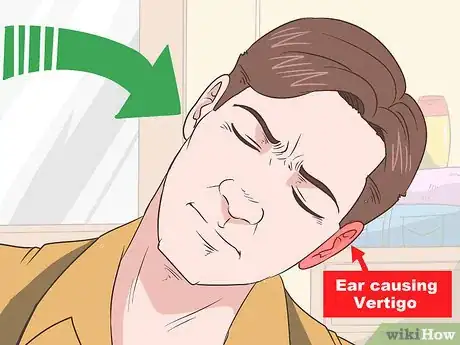



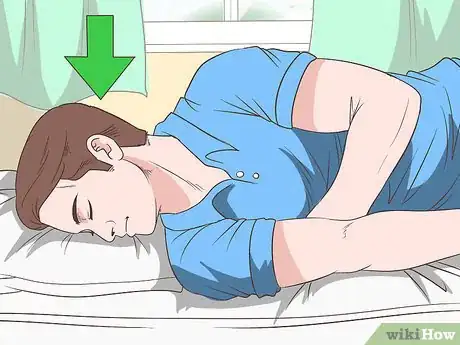




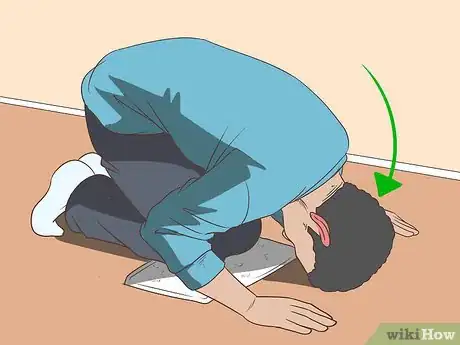
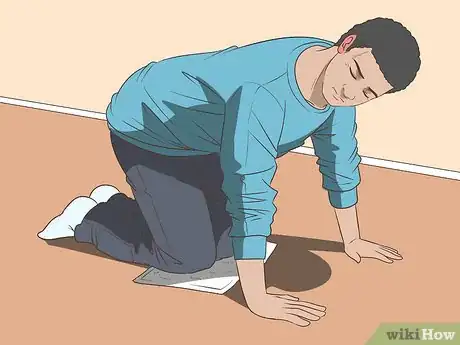
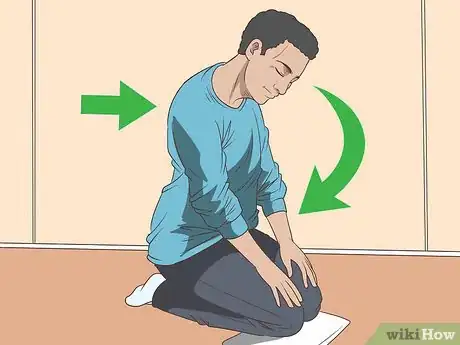








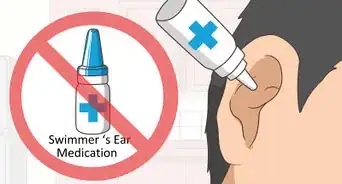

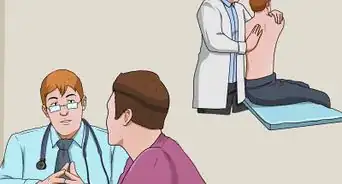


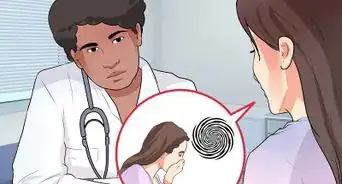














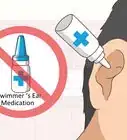
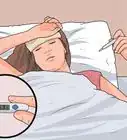






































Medical Disclaimer
The content of this article is not intended to be a substitute for professional medical advice, examination, diagnosis, or treatment. You should always contact your doctor or other qualified healthcare professional before starting, changing, or stopping any kind of health treatment.
Read More...